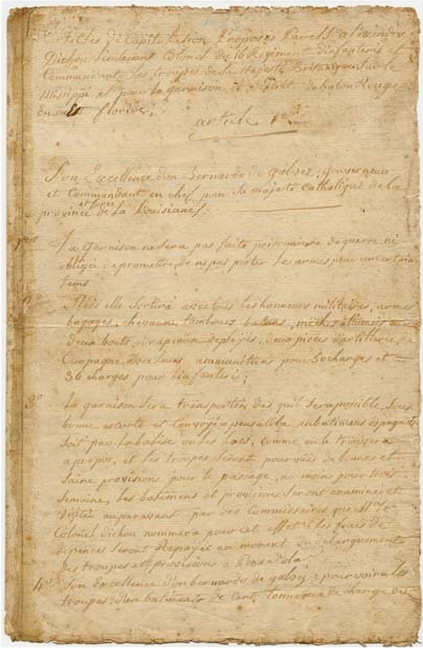bloc_article_content
The Louisiana Purchase (1803)
In 1803, Louisiana, which France had ceded to Spain in 1762, became French again for only three weeks before being purchased by the United States.
Louisiana, which was founded by naval officers in the name of Louis XIV in 1699, remained under French rule for just two generations. The Seven Years War (French and Indian War), which had started in 1754 in the Ohio valley, ended with a series of military disasters for France that forced it to cede its territories in North America, in order to retain control of Guadeloupe. In 1762 and 1763, the treaties of Fontainebleau and Paris divided French Louisiana, which extended theoretically from the Appalachians to the Rocky Mountains and from the Gulf of Mexico to the Great Lakes: Great Britain received the area to the east of the Mississippi, while Spain took New Orleans and the west bank. With the territory that passed into British hands being incorporated into West Florida, the name Louisiana was now reserved for the Spanish colony.
In 1768-69, elite Louisianans revolted against the imposition of Spanish sovereignty, but they ultimately accepted it in the decades that followed as they prospered thanks to the 1772 reopening of the slave trade. In some quarters, the French Revolution reignited a desire to return to French control. The French government received a series of petitions from the inhabitants of Louisiana requesting reunion with France. Under the Directory (1795-1799), France sought in vain to obtain a retrocession of the terms of the 1795 Peace of Basel. The authorities then sent General Georges-Henri Victor Collot on an expedition in the Ohio and Mississippi valleys in order to assess the feasibility of such a project. In 1803, before being expelled by governor of Louisiana Baron de Carondelet, Collot wrote an account of his journey, Voyage dans l’Amérique septentrionale, which was not published until 1826.
Conceived during the Directory, the project to re-annex Louisiana was not implemented until Bonaparte rose to power in 1799. His desire to thwart the British Empire by controlling the route to the Indies had failed in Egypt. Influenced by members of his government who had links to the Caribbean -- François Barbé-Marbois, Pierre Malois and Médéric-Louis Élie Moreau de Saint-Méry -- he decided to restore France’s Ancien Régime empire in the Americas. Recapturing the lead in colonial commerce first required retaking Saint-Domingue from Toussaint Louverture, who governed the colony independently, and reestablishing slavery there. The secondary role assigned to Louisiana was to provision the colonies of Saint-Domingue with wood, flour, and other staples.
New negotiations with Spain led to the October 1800 signing of the secret Treaty of San Ildefonso which ceded Louisiana to France in exchange for an expansion of the Duchy of Parma. The King of Spain Charles III also preferred that Mexico’s neighbors be French rather than the United States which, in 1795, had already obtained from the Spanish the right to navigate freely on the Mississippi and to store goods in New Orleans. The reprisal of hostilities with England delayed the treaty’s implementation. In the years that followed, numerous publications nonetheless touted this projected renaissance of French Louisiana. After the conclusion of the Peace of Amiens in March 1802, the prefect Pierre-Clément de Laussat was sent to New Orleans. On 30 November 1803, he officially retook possession of the colony in the name of France; three weeks later, on 20 December 1803, he had to organize a second ceremony in order to turn the territory over to the United States.
On April 30, 1803, Napoleon sold Louisiana to President Jefferson. The United States had looked askance at the reconstitution of a French power in the heart of the continent, fearing a centripetal effect on territories west of the Appalachians. At first, Jefferson wanted only New Orleans and possibly the two Floridas. But Napoleon had lost all interest in Louisiana after the failure of Leclerc’s expedition in Saint-Domingue. With the threat of a new war with Great Britain looming, New Orleans and the Mississippi Valley had to be protected from British seizure. In spite of their far more limited instructions, the American negotiators in Paris, Robert Livingston and James Monroe, agreed to purchase all of Louisiana for 80 million francs (15 million dollars). While the Federalists registered their opposition, Jefferson welcomed this acquisition because it removed the British threat. In 1812 the Territory of New Orleans -- a small portion of the lands purchased for this paltry sum -- became a State of the Union under the name Louisiana.
Political Boundaries of North America in the Era of the Louisiana Purchase

Published in may 2021
Réduire l'article ^






